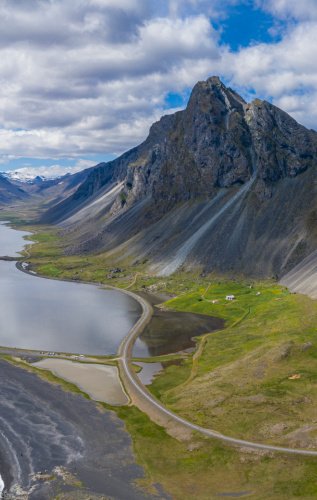Road Conditions in Iceland
Self-drive tours around Iceland are a popular mode of travel. The sights along the way are numerous and breathtaking. But this beautiful and rugged landscape can also create challenges that drivers may not have come across in other countries. Make sure you are fully prepared and know the rules of the road.
Icelandic Roads - The Icelandic road system is extensive and easy to navigate. Highway no. 1, commonly known as the Ring Road, is the most travelled route around Iceland. It is open throughout the year, but weather conditions can cause temporary closures during winter. Most major highways are paved, but it may surprise travellers to learn that a large portion of the Icelandic road system is made up of gravel roads, particularly in the highlands. Gravel roads can be in various conditions, with potholes or washboard surfaces, but most of the time they should give a good ride if care is taken. You should always navigate these roads with care, as loose gravel can be difficult to drive in. Be careful when you pass another vehicle. Sand and small rocks can easily cause damage to cars, such as cracked windshields or a ruined paint job.
Consider the Weather - Driving in Iceland demands certain attention to conditions. Especially if you plan on travelling into the highlands. Be sure that you have the right car for the job. A 4x4 vehicle is essential in the highlands, where you might encounter rough terrain and unbridged waters. The highland roads are closed in winter times and the weather sometimes causes other roads to be closed as well. If driving in winter, you can expect to face snow, icy roads and darkness. If you are travelling outside of populated areas, always make sure that you check weather conditions and the state of your vehicle. As much fun as Icelandic nature is, you will still want to find your way back eventually.
Mountain Roads - Most mountain roads are closed until the end of June, or even longer, because of snow and muddy conditions, which make them impassable. When these roads are opened for traffic many of them can only be navigated by four-wheel-drive vehicles. For some mountain tracks, it is strongly advised that two or more cars travel together. Check road conditions with a tourist information centre or the IRCA Website
Off-Road driving - Off-road driving in Iceland is prohibited by law. Due to our short summers, Icelandic soil and vegetation are extremely vulnerable. Tire tracks can leave marks for decades.
PLEASE NOTE - Special warning signs indicate danger ahead, such as sharp bends, but there is generally no separate sign to reduce speed. Please choose a safe speed according to conditions. Motorists are obliged by law to use headlights at all times, day and night. Passengers in the front and backseats of an automobile are required by law to use safety belts. Icelandic law forbids any driving under the influence of alcohol and driving while talking on a mobile phone is also banned. The general speed limit is 50 km/h in urban areas, 80 km/h on gravel roads in rural areas, and 90 km/h on asphalt roads.
Please respect Icelandic nature and tread carefully.
USEFUL WEBSITES

